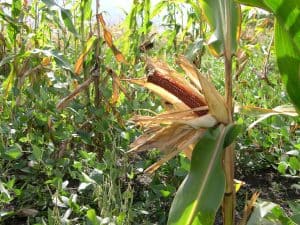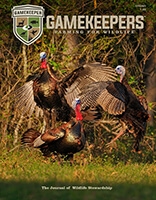In the world of deer management, broadcasting corn for food plots is sometimes overlooked because corn often gets a bad rap due to its association with feeding and baiting — especially when it disrupts a whitetail’s four-chambered stomach if fed incorrectly. This is true — if you all of a sudden offer corn to a hungry herd of whitetails mid-winter when they haven’t had any corn to eat prior, you will likely see a herd with the “squirts.”
However, we’re not going to cover feeding corn to deer that way. We’re talking about planting corn as a food plot crop. In this case, in my opinion, corn definitely deserves a place on your food plot menu. And because the corn is growing and not suddenly introduced mid-winter, there shouldn’t be any ungulate gut issues as long as native foods and/or other crops are also available.

Todd Amenrud
Nutritional Benefits of Corn for Whitetails
Corn’s protein content varies by variety from around 8 to 15%. So, it’s not the best choice for protein, but it has other nutrients that are very important to deer. One of the most important components is carbohydrates. The highly digestible carbohydrates mean energy and warmth for whitetails.

Dstroik
Corn contains many other essential vitamins, minerals, fiber and antioxidants, like essential fatty acids for a healthy skin and coat. Starch is its main carb, making up around 28% to as much as 80% of its dry weight. Corn also provides small amounts of sugar.
Corn Yield vs. Other Food Plot Crops
The yield is a bit different than other food plot crops, too. Let’s compare corn with my favorite planting—brassicas. It obviously matters which variety of brassica you’re planting, but I know the numbers from being involved in testing back in the ’90s, and I’m using the data from a test we did on a research farm in Quebec.
In 2023, the average corn yield in the United States was estimated at a record high 177 bushels per acre. An average bushel of corn weighs 56 pounds, so 177 x 56 = 9,912 pounds of corn per acre. In our Quebec test, brassicas (rape) yielded 65,755 pounds per acre. So brassicas can yield over six times more food per acre than corn.
With limited acreage, a gamekeeper has tough questions to answer. However, most every deer hunter understands how attractive corn can be at times.
Why I Prefer Wildlife Sweet Corn
Sweet corn is a special low-starch variety with higher sugar content, at 18% of the dry weight. Most of the sugar is sucrose and deer love it. This is why BioLogic’s Wildlife Sweet Corn is often my “go-to.” They will walk past the corn we cash-crop on our property to get to a plot of my BioLogic Sweet Corn.
Deer Habitat and Still-Hunting in Corn Fields

Todd Amenrud
Whitetails will live/bed right in your corn field. Back in the day (yes, I know I’m becoming an old fart), corn used to be planted in fairly wide 36 to 44-inch rows. This left space for deer to bed between the rows. On windy or rainy days, I used to “stalk the stalks,” so to say, and still-hunt corn fields.
Now days, current row widths typically vary from 15 to 38 inches, with most producers at 30 inches. Broadcasting corn creates even more randomness. Deer still bed in these fields, but both are more difficult to still hunt because of the skinnier rows or broadcast pattern.
Debunking the Corn Planter Myth
Some managers believe you need two things to plant corn – adequate acreage and a corn planter or drill.
Oh contraire mon frère … although you will need enough acreage to keep up with the amount of pressure your animals are putting on it, you don’t necessarily need a corn planter or drill. Corn can simply be broadcasted!
How Much Corn Should You Plant?
Looking at the “density to acreage” issue, you will need enough acreage in corn to keep up with the amount of deer, turkeys and other animals feeding on it. This magical number will vary depending upon many factors — your location, quality and amount of native foods, total acreage planted, nearby farming, etc.
Success with corn can be had with plots as small as two acres in areas with low density or cash-crop farming nearby. However, in high-density areas, you’ll likely need at least four to six acres, and possibly ten to twelve acres if there’s no local corn farming.
How to Broadcast Corn Without a Planter
OK, you’ve got the acreage, but no corn planter. Worry not. Corn can be broadcasted, as can other larger seeds like beans or peas.
When broadcasting larger seeds, I prefer a somewhat fluffier seedbed so the soil covers the seeds easier. The key is finding a way to bury the correct amount of seeds at the appropriate depth.
Any type of broadcaster will do. Since not every seed will be buried at a uniform depth, increase your seed rate by 15 to 20%.
Tools for Covering Broadcasted Corn Seed

Possibly the most important detail is finding an implement that will cover the seeds to the right depth. I’ve had success with certain cultipackers, disks, drags, and harrows.
Disking rule of thumb: Set it at twice the depth you want the seeds planted. A 1-inch planting depth means a 2-inch disk setting. You may need to fine-tune your setup, but I’ve broadcast-plant corn all the time with success.
Broadcasting Corn for Absentee Landowners
As an absentee landowner or working on someone else’s property, hauling a corn planter isn’t practical. I used to plant corn and soybeans on my Ontario property this way every year.
There, I needed a short 72-day maturation variety due to the short growing season. The stalks didn’t get very tall, but it cobbed-out well and the deer devoured it.
Why I Use a Harrow to Cover Corn Seed
I’ve tried covering corn seed with a disk, but my preferred method is to use a harrow (sometimes called a drag or harrow-drag). These are typically 4′ x 6′ sections with 8-inch angled tines. They can be adjusted for aggressive, medium, or light coverage, depending on the seed size.
Mixing Corn and Soybeans in Your Food Plot

Todd Amenrud
You may also consider planting corn and soybeans together. Since corn won’t yield until late summer or fall, beans provide summer forage and help protect young corn stalks from browsing.
The two plants also complement each other. Beans fix nitrogen that corn needs, and corn provides structure for the beans. This is a modern twist on the Native American “Three Sisters” technique, minus the squash.
Recommended Corn-to-Bean Ratios
If you’re mixing corn and beans, I’ve used 10% to 20% corn with the rest soybeans. Around 15% corn seems to work well. I often plant a couple of bean varieties—one for forage, one for pods—and do the same with corn: one early maturing and one heavy yielding.
Final Thoughts on Broadcasting Corn for Food Plots
If you choose to plant your corn separately, go by the instructions for that specific variety and increase the seeding rate by 15 to 20%. Again, the most important detail is covering your seeds at the right depth, and there are many ways to get the job done.
Broadcasting corn is absolutely doable for absentee landowners, budget-conscious managers, and those without big equipment. While corn doesn’t yield as much as brassicas, it plays a vital role in a food plot program, especially in winter. It’s a high-energy source for deer, game birds, and even waterfowl.









